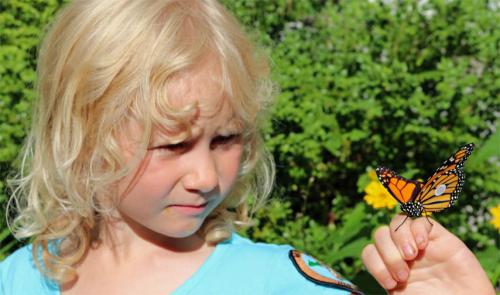Citizen science in schools affords place-based education opportunities for students
Adopting beaches, tagging migrating monarch butterflies, and mapping habitats for endangered species are a just few of the hands-on ways in which teachers and students can get involved as citizen scientists.

As a new school year gets underway, teachers may be looking for opportunities get students outside this fall. A number of Great Lakes and natural resources citizen science partners and programs offer fun, engaging and scholarly opportunities for students to contribute to their community while exploring the local environment.
A variety of people engage in citizen science by learning, collecting information or data, and contributing to Great Lakes research and studies. Working with scientists in this way, citizens add value to the work of scientists working to monitor habitats, track populations, and address questions about our environment. Connecting schools, teachers, and students in citizen science activities offers a value well beyond science and data collection.
Citizen science can also serve as a place-based education experience where students, through their learning, can contribute toward meaningful environmental stewardship service that makes a difference. It exposes students to relevant conservation issues and career opportunities; and in their civic engagement experience, students can serve as local leaders in this ‘watch dog’ role for in their communities. Most importantly, students can have fun and enjoy an outdoor experience while accomplishing their school learning goals.
The following citizen science opportunities are just a few examples that are open to student involvement. These opportunities have proven attractive to teachers for both their ease in getting started and the learning experiences they offer for students:
- Great Lakes Adopt-a-Beach: Middle school students from Thunder Bay Jr. High and Oscoda Schools hit the beaches with the Alliance for the Great Lakes. As part of this program, students led a beach clean-up project, while collecting science-based data to assess beach health.
- Great Lakes FieldScope: Students from AuGres-Sims Elementary contributed water quality data from their watershed, helping to pilot this citizen-science website supported by Michigan Sea Grant and National Geographic Society.
- Midwest Invasive Species Information Network (MISN): Aids Michigan Natural Features Inventory in the hunt for invasive species. Learning about these invaders and how to identify them, map findings using a smart phone application, and submit the findings to the
 online monitoring database.
online monitoring database. - Monarch Watch: Mark migrating monarch butterflies. Great Lakes coastlines serve as critical migratory corridors for birds, bats, and butterflies; and students can aid the monitoring and biodiversity conservation by helping to track monarch populations in the Great Lakes region.
- Michigan Frog & Toad Survey: The Michigan Dept. of Natural Resources (DNR) relies on people to listen each spring for the calls of breeding frogs and toads. These annual citizen-collected records help monitor populations of Michigan’s thirteen frog and toad species.
- The Great Backyard Bird Count: Learn to identify birds by color and call, and go on the search for birds in their habitats. Count birds with the National Audubon Society, Cornell Lab of Ornithology, and others—students just enter their findings online.
- Endangered Hine’s Emerald Dragonfly Habitat Study: Alcona County youth are part of a coastal community science effort in northeast Michigan. Here, citizens are working with Michigan State University Extension Michigan Natural Features Inventory, Michigan DNR, U.S. Fish and Wildlife Service, Huron Pines, and Michigan Sea Grant researchers in mapping Hine’s Emerald Dragonfly habitats along the Lake Huron coastline.
- 4-H Youth Conservation Council: Coordinating with Michigan 4-H Youth Development, this opportunity offers youth leaders a chance to connect citizen science with public policy decision-making processes. Students gather information and collect data on an environmental issue. Around Earth Day, they present their findings (with policy recommendations) to the Michigan State Senate.
Citizen science offers a fun and meaningful way in which students, through their learning, connect with their community and environment. Part 2 of this series will explore the opportunities (and pitfalls to be avoided) in advancing place-based education programming through citizen science involvement.



 Print
Print Email
Email


